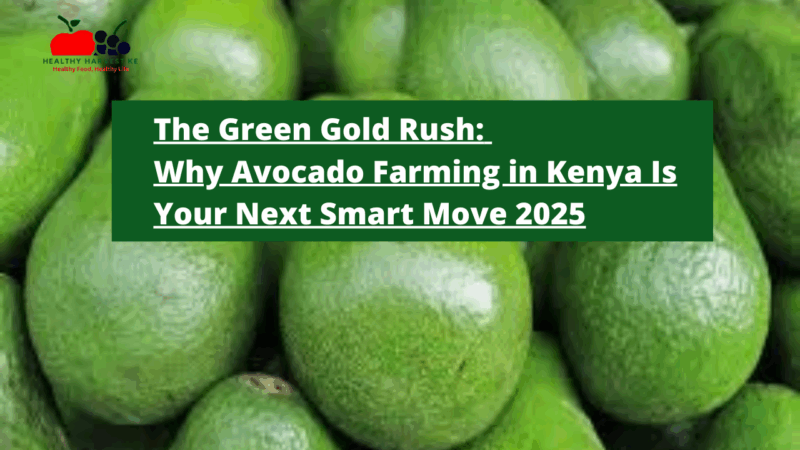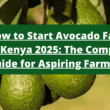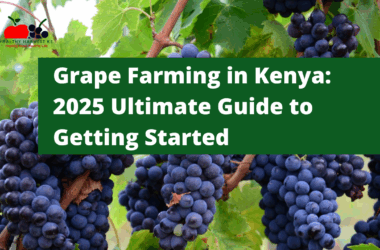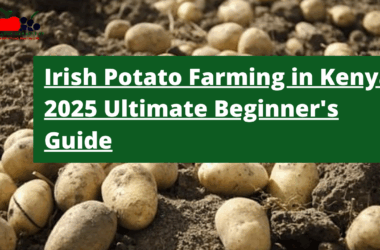Ever noticed how that $15 avocado toast at your favorite brunch spot keeps creeping up in price? There’s a reason – and it’s creating serious opportunities halfway across the world. Kenya’s avocado scene isn’t just growing – it’s exploding. And if you’re looking for the next big agricultural play, you might want to pay attention.
Kenya has quietly become Africa’s avocado powerhouse, ranking seventh globally with production hitting a massive 417,000 tonnes in 2022. That creamy green gold is transforming the country’s agricultural landscape and creating serious wealth for those who get in on the action.
Let’s break down why Kenya’s avocado boom matters and how you could potentially be part of it.
The Kenyan Avocado Revolution: What Makes It Different
Kenya isn’t new to the agricultural game, but what’s happening with avocados is next level. The country now leads the entire African continent in avocado exports, leaving competitors like Ethiopia (152,000 tonnes in 2022) in the dust.
Why? It’s the perfect storm of ideal growing conditions, government backing, and smart market positioning. Kenya’s position as Africa’s premier avocado producer stems from a combination of favorable agricultural conditions and strategic development initiatives.
The real magic happens with the Hass variety – those dark, bumpy avocados that turn purplish-brown when ripe. Hass dominates Kenya’s export market because they travel well and have the rich, buttery texture that international markets crave. When you’re paying premium for guacamole in London or Berlin, chances are you’re tasting Kenyan Hass.
Show Me The Money: The Economics of Avocado Farming
Let’s talk numbers that matter. In 2022, Kenyan farmers were getting about Ksh 18 (roughly $0.14) per kilogram at the farm gate. Not impressed? Here’s the kicker – those same avocados were fetching around Ksh 150 ($1.20) per kilogram in export markets.
That’s an 8x value jump – and exactly why getting into the export game changes everything.
A mature avocado tree can produce up to 1,000 fruits per season. Do the math on a small orchard of 100 trees, and you’re looking at serious returns over the 20-year productive lifespan of these trees.
Unlike seasonal crops that leave you hanging between harvests, avocados provide near-year-round income. That consistent cash flow is why smart farmers are pivoting to this crop.
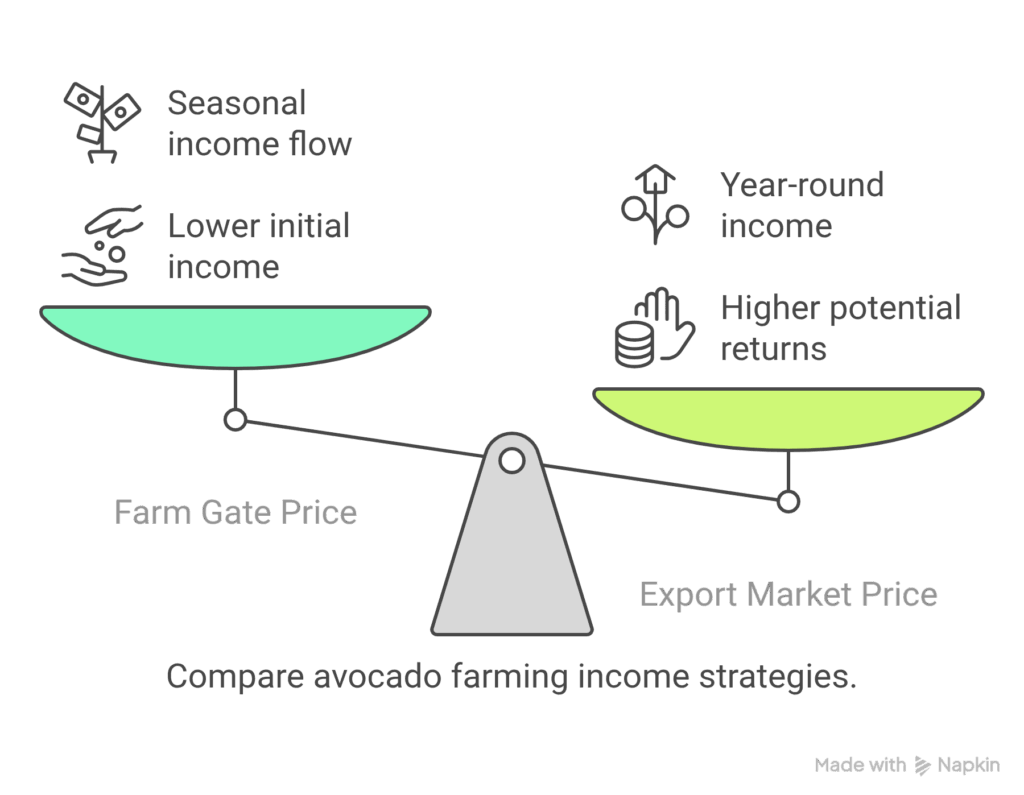
The Perfect Conditions: Where Avocados Thrive in Kenya
Kenya’s success with avocados isn’t random luck – it’s geography. The country has multiple regions with the ideal mix of elevation, rainfall, and soil conditions that avocados love.
Bomet County in the South Rift region has emerged as an avocado hotspot, with the local government distributing over 189,720 subsidized quality seedlings since 2017. The county government’s commitment to this crop shows just how seriously they’re taking the opportunity.
But here’s the insider tip – western Kenya is the next frontier. Areas around Bungoma, Kisumu, and parts of Nyanza have perfect growing conditions but haven’t been fully tapped yet. KALRO (Kenya Agricultural and Livestock Research Organisation) has identified this region as having prime potential, creating a ground-floor opportunity for early movers.
Getting Started: What You Need to Know
Starting an avocado farm in Kenya isn’t complicated, but there are non-negotiables if you want to succeed:
Quality Seedlings: Your Foundation for Success
Your entire operation hinges on starting with certified seedlings. KALRO has established seedling multiplication centers across Kenya, including the Kibos center in Kisumu, producing 320,000 seedlings annually.
These seedlings are certified by KEPHIS (Kenya Plant Health Inspectorate Service) – think of it as quality assurance for your investment. Paying more upfront for certified seedlings is your insurance policy against poor yields later.
Water Management: The Lifeblood of Your Orchard
Avocados need approximately 1600mm of well-distributed annual rainfall. Translation: consistent water access is crucial. Many successful operations supplement natural rainfall with irrigation systems during dry periods.
The good news? Avocados are adaptable to different rainfall conditions, but consistency is key. Water stress during critical growth phases can tank your yield, so having a water management plan is essential.
Space and Patience: The Long Game
These aren’t get-rich-quick crops. Proper spacing between trees (typically 7-10 meters depending on variety) ensures they have room to develop. Many farmers plant short-term crops between young avocado trees to generate income during the establishment phase.
The waiting game is real – most trees take 3-4 years before commercial production begins. But once they start producing, you’re looking at decades of returns.
Battle Plan: Tackling Pests and Diseases
Every farming operation faces challenges, and avocados are no exception. Kenya’s most common avocado enemies include:
The Pest Lineup
- Spider mites: These tiny troublemakers cause brown spots and leaf drop. The fix? Proper pruning, adequate irrigation, and washing leaves with high-pressure hoses.
- Insect borers: These tunnel into trees and weaken branches. Early identification and removal of infected branches is your best defense.
- Scales: Small, stationary insects that suck sap from leaves. While they don’t damage the fruit inside, they can lead to export rejection due to aesthetic issues.
- Fruit flies: These lay eggs under the fruit skin, causing lesions and premature fruit drop. Orchard sanitation and targeted baiting programs keep them in check.
Disease Management
The biggest threat? Avocado root rot, caused by Phytophthora cinnamomi. This pathogen attacks the root system and can eventually kill trees if not managed. Preventative approaches focusing on drainage improvement and careful irrigation management are your first line of defense.
Stem end rot and anthracnose also pose challenges, particularly for fruit destined for export markets where appearance standards are strict.
Leveling Up: Value Addition and Export Markets
Growing great avocados is just the beginning. The real money is in value addition and export markets:
The Infrastructure Revolution
Bomet County is leading the way with a state-of-the-art avocado packhouse costing Sh180 million. This facility will handle everything from cleaning and sorting to waxing, grading, and packaging – essentially preparing avocados for the premium international market.
The beauty of these facilities is that they extend beyond county borders. The Bomet packhouse will serve neighboring counties including Kericho, Nyamira, and Kisii, creating regional economies of scale.
Going Global: Export Opportunities
Kenya’s strategic position in global avocado markets keeps strengthening. New infrastructure like cargo flights from Kisumu International Airport now makes direct exports from western Kenya possible, opening opportunities for farms in previously overlooked regions.
The cold chain is critical here – temperature-controlled storage and transport ensures your avocados reach distant markets in perfect condition, commanding premium prices.
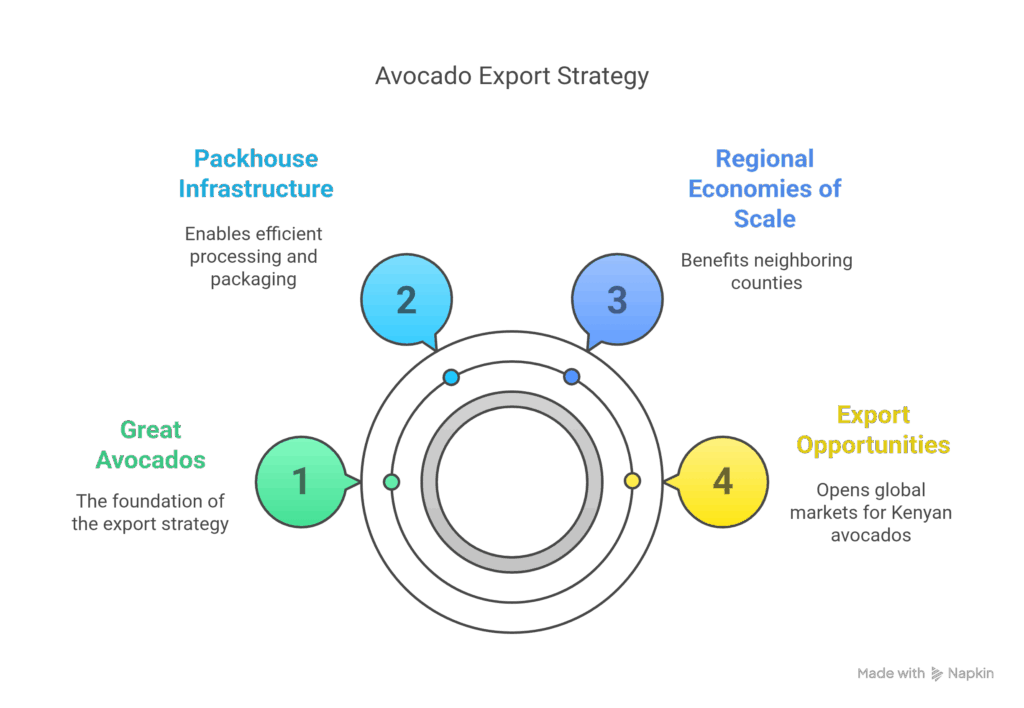
The Support System: Who’s Got Your Back
Going solo in agriculture is tough, but Kenya’s avocado sector has serious backup:
Government Muscle Through KALRO
KALRO isn’t just researching – they’re actively expanding avocado farming through seedling propagation and farmer education. Their centers across Kenya are producing certified seedlings and conducting farmer field days to spread knowledge about best practices.
They’ve even innovated with flexible payment terms, allowing farmers to place orders for seedlings with payment terms up to 60 days – essentially removing cash flow barriers to entry.
International Partnerships
The USAID-funded Kenya Crops and Dairy Markets Systems (KCDMS) program has been a game-changer across 12 counties. This six-year initiative has strengthened value chains, trained farmers, improved access to finance, and created a more supportive business environment.
The program has facilitated knowledge transfer through benchmark trips to established avocado regions like Muranga, allowing newer farming communities to learn from success stories.
Beyond Fresh Fruit: Diversification Opportunities
The smartest players in this space aren’t stopping at fresh avocados. Value-added products like avocado oil and cosmetics offer additional revenue streams and protection against price fluctuations.
With global demand for avocado-based products growing in both food and beauty sectors, processing operations represent the next evolution of Kenya’s avocado industry.
Climate Change: The Unexpected Opportunity
Here’s an angle most people miss – climate change is actually creating opportunities in Kenya’s avocado sector. As traditional coffee-growing regions face climate-related challenges, many farmers are switching to avocados, which show greater resilience to changing weather patterns.
This transition is happening organically as farmers seek crops that can withstand increasingly unpredictable conditions while still commanding premium prices.
Your Next Move: Getting In The Game
Whether you’re looking to invest directly in farming operations, partner with existing producers, or explore value-chain opportunities, Kenya’s avocado sector offers multiple entry points:
- Direct farming: Acquire land in emerging regions like western Kenya where prices remain reasonable
- Contract farming: Partner with smallholder farmers who need capital and expertise
- Value addition: Invest in processing facilities for oil extraction or cosmetic production
- Export services: Develop specialized logistics services for this growing sector
The Bottom Line
Kenya’s avocado industry represents that rare sweet spot – a sector with proven success but still plenty of room to grow. The country’s position as Africa’s leading producer and seventh globally gives it the scale and credibility to compete internationally, while emerging regions and value-addition opportunities provide new frontiers for expansion.
For those willing to play the long game and navigate the inevitable challenges of agricultural development, Kenya’s green gold rush offers compelling potential. The avocado on your toast might just be your next investment opportunity.
Ready to dig deeper? The resources linked throughout this article provide data-backed insights to guide your next steps in exploring Kenya’s avocado sector.
Frequently Asked Questions About Avocado Farming in Kenya
How much does it cost to start an avocado farm in Kenya?
Initial investment varies widely depending on scale, region, and infrastructure needs. For a small operation (1-2 acres), expect to invest approximately KSh 300,000-500,000 ($2,400-4,000) covering land preparation, quality seedlings, irrigation setup, and initial inputs. Larger commercial operations can require millions in capital. The good news? The long productive lifespan of avocado trees (20+ years) means your ROI improves significantly after the initial 3-4 year establishment period.
Which avocado variety makes the most money in Kenya?
Hass dominates the export market and commands premium prices due to its excellent shelf life, consistent quality, and international demand. While you’ll find over 40 varieties growing across Kenya, commercial operations overwhelmingly focus on Hass for export markets and Fuerte as a secondary variety. Emerging varieties like Gem and Lamb Hass are gaining traction but haven’t yet matched Hass in commercial scale.
How long before my avocado trees start producing income?
Most grafted avocado trees begin bearing commercial quantities of fruit around year 3-4, though you might see limited production earlier. Production typically increases year-over-year until trees reach full maturity (around year 7-8). Many farmers intercrop with short-term crops like beans or vegetables during the establishment phase to generate income while waiting for avocados to mature.
Do I need a large farm to be successful with avocados?
Not necessarily. While commercial scale offers advantages for export markets, many successful operations begin with just a few acres. Smallholder farmers with just 50-100 trees can generate significant income once trees reach maturity. Joining cooperatives or working with aggregators can help smaller producers access export markets that might otherwise be challenging to enter independently.
What’s the best region in Kenya to start avocado farming?
Traditional avocado belts include counties like Muranga, Kiambu, and Nyeri in central Kenya. However, Bomet in the South Rift has emerged as a major hub with substantial government support. For value opportunities, western Kenya (including Kisumu, Bungoma, and parts of Nyanza) offers suitable growing conditions with lower land prices and less competition. Your specific site should have well-drained soils, adequate rainfall (or irrigation access), and protection from extreme winds.
How do I handle certification for export markets?
Export certification involves meeting both national and international standards. Start by registering with the Horticultural Crops Directorate (HCD) and working toward Global G.A.P certification, which most European importers require. Connect with established exporters who can guide you through requirements for specific markets. Japan and China have particularly strict phytosanitary requirements that necessitate careful production practices from planting through harvest.
What’s the biggest mistake new avocado farmers make?
Underestimating water requirements during establishment is the classic rookie error. Young avocado trees need consistent moisture to develop strong root systems. Other common mistakes include poor variety selection for your specific region, inadequate pest monitoring, and harvesting at improper maturity. Perhaps the most costly mistake is failing to plan for the 3-4 year establishment period when trees require investment but generate minimal returns.




